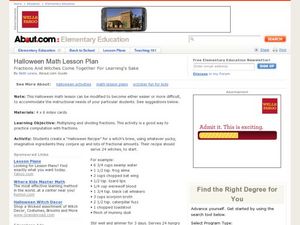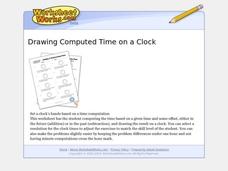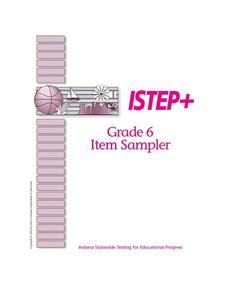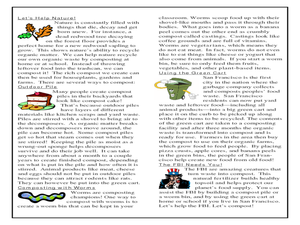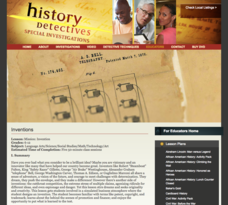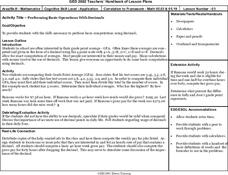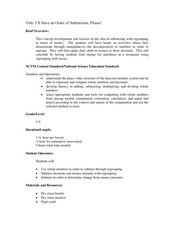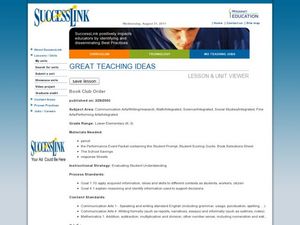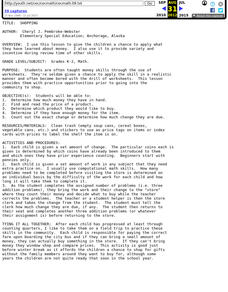Curated OER
Halloween Math Lesson Plan
Young scholars practice their multiplication and division by creating a Witches Brew. In this holiday math lesson, students utilize Halloween style ingredients to create a fun edible treat for themselves. Young scholars...
Curated OER
Drawing Computed Time On A Clock
In this drawing computed time on a clock worksheet, students explore and analyze how to set a clock's hands based on a time computation. Students either offset the time for the future (addition) or in the past (subtraction).
Curated OER
Computing Time With Two Clocks
In this computing time with two clocks activity, students determine and analyze time differences between two clocks. Students either choose time in the future (addition) or in the past (subtraction).
Curated OER
Slowly But Surely
The US mint has created this fabulous lesson plan, which practices language arts and mathematics skills. Learners will use the provided worksheets and step-by-step instructions to experiment with different sentence structures, use...
NTTI
Putting Together Ten
Groups explore sets of 10 items in two varieties (i.e. 3 white buttons and 7 black ones, or 5 bears and 5 bunnies). They brainstorm about their objects, write math sentences to represent what they have, and report their discoveries...
Curated OER
ISTEP + Grade 6 Item Sampler
In this cross-curricular sampler of worksheets, students determine the meaning of specialized vocabulary and to understand the precise meaning of grade-level-appropriate words, describe and connect the essential ideas, arguments, and...
Curated OER
Shel Silverstein Poetry Math
Fifth graders explore the connection between poetry and math by reading poems that involve numbers. In this Shel Silverstein poetry math lesson, 5th graders listen to 5 poems read aloud and discuss how math was used in the...
The New York Times
Understanding the Mathematics of the Fiscal Cliff
What exactly is the fiscal cliff? What are the effects of changing income tax rates and payroll tax rates? Your learners will begin by reading news articles and examining graphs illustrating the "Bush tax cuts" of 2001 and 2003. They...
Curated OER
Time Travel, Black Holes, and Relativity
Learners read the novel, The Time Machine, and compare H.G. Well's perceptions of the future with those presented in The Third Wave, by Alvin Toffler. They research current scientific and mathematical theories that relate to space and time.
Curated OER
Balloons: Math with the Montgolfier Balloon
Students discover the history of hot air balloons by watching one ascent. In this physics lesson, students utilize a Montgolfier Hot Air Balloon from an earlier lesson and record the temperature, rate of ascent and the volume....
Curated OER
Using Negative Numbers
Sixth graders practice using negative numbers by completing number equations. For this math problem solving lesson, 6th graders discuss the different ways negative numbers can be used in a math problem and practice completing...
Curated OER
Let's Build a Worm Bin
Students explore the process of decomposition. In this ecology and measurement lesson, students prepare a worm home to be used for vermicomposting. Students weigh a group of worms and the added food, recording this information on a data...
Curated OER
Opinion Poll-arities
Students explore the mathematics behind opinion polls, as well as provides a framework for interpreting trends in opinion poll graphics.
Curated OER
Three Easy Steps to Help Your Pupils Avoid the Summer Slide
By engaging parents in their kids’ learning over the summer, you can help make sure your pupils kick the summer slide to the curb.
PBS
Inventions
Use this lesson plan to discuss inventions that have changed your class's world and have impacted society. Middle schoolers investigate important inventions of their time and design an invention in a simulated business atmosphere. Modify...
Curated OER
Basic Operations with Decimals
Twelfth graders practice skills adding and dividing decimals. They examine the help wanted ads and compute the hourly and weekly wages. They discuss the real life value of understanding the importance of decimals.
Curated OER
I'll Have an Order of Subtraction Please!
Students explore number values by completing consumer math worksheets. In this math functions lesson plan, students identify the use of a decimal in numbers and the place values that are represented when dealing with money. Students...
Curated OER
Diamond Problems
Diamond problems are a great way to have students solve and complete 5 various types of problems that include measurement and using algebra tiles to solve expressions. First, they copy each diamond and solve it. Then, 8th graders compute...
Curated OER
Buying Cars/Financing Cars Compound Interest
Provide a real world context in which exponential functions are used to determine a eal world phenomena such as compound interest and exponential growth. This instructional activity should be taught after students have mastered the laws...
Curated OER
Book Club Order
Young scholars complete a simulated book order form for their class. In this book club instructional activity, students budget and plan an order form for their fellow young scholars, discussing why they chose specific books.
Curated OER
Functions
In this functions worksheet, students solve and complete 5 different sets of problems that include determining functions on intervals. First, they define a definite integral and the Fundamental Theorem of Calculus. Then, students draw a...
Curated OER
Johnny Appleseed Walkabout
Second graders calculate mileage for a journey. In this place value and measurement lesson, 2nd graders read Johnny Appleseed, work in groups to locate his birthplace on a map, locate the other states he stopped in, and measure the...
Curated OER
Measure Up!
Discover ways to measure items without standard tools. In this measurements lesson, learners estimate how long certain objects are by measuring with a non-standard measuring tool. Students check their estimates with a ruler and share...
Curated OER
Shopping
Students do a shopping simulation in order to have a chance to apply their math skills in a real life fashion. They decide how much money they have, what they want to buy, if they have enough money and how much change they should get back.
